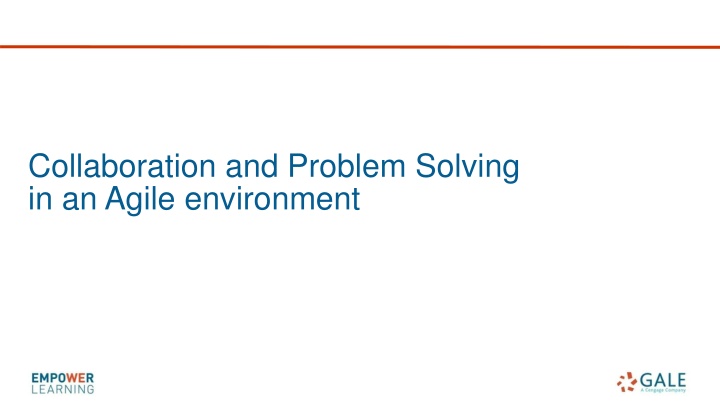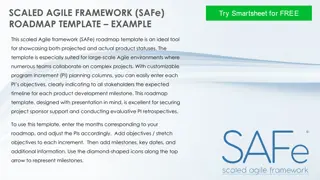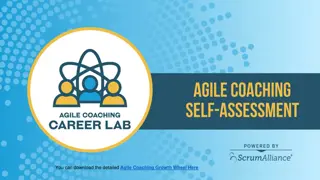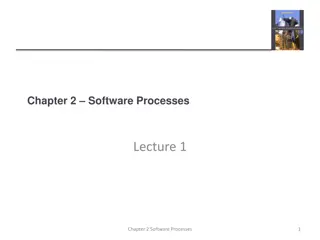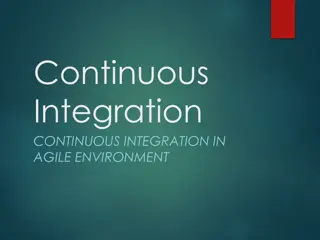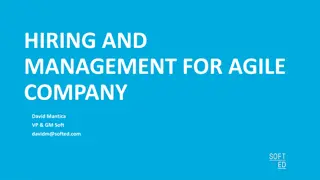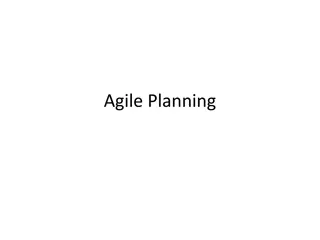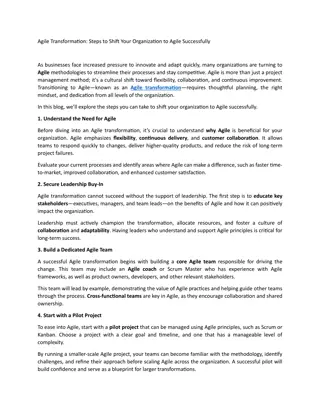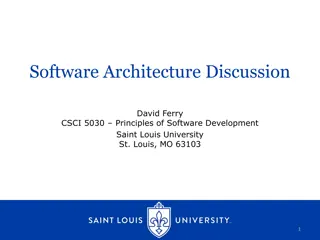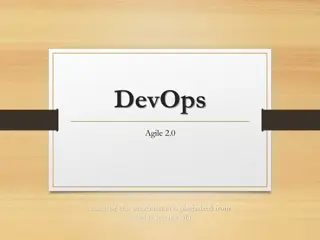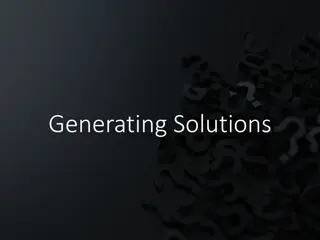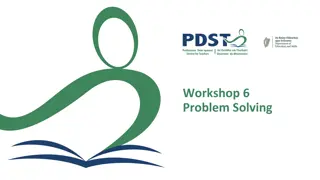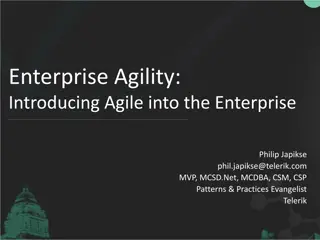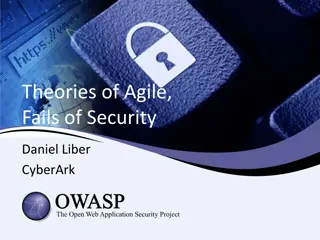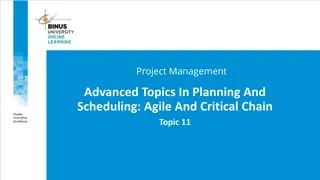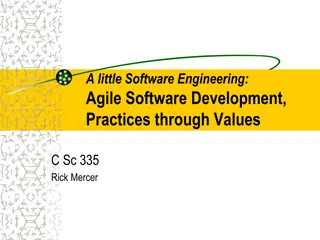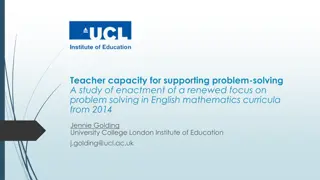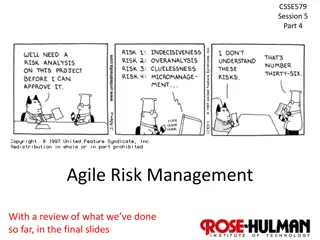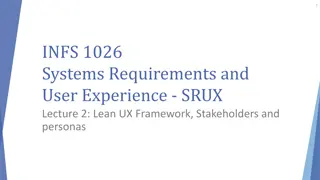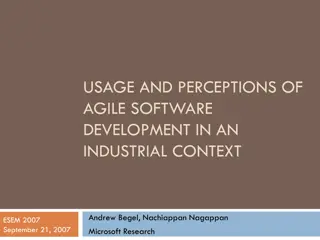Enhancing Collaboration and Problem-Solving in Agile Environments
Foster better collaboration and problem-solving in Agile settings through iterative cycles of development, linked data initiatives, and coordinated efforts to overcome challenges faced by large research libraries. Explore the shift from traditional project approaches to Agile methodologies and the importance of user experience and funding in driving successful outcomes.
Uploaded on Mar 15, 2025 | 3 Views
Download Presentation

Please find below an Image/Link to download the presentation.
The content on the website is provided AS IS for your information and personal use only. It may not be sold, licensed, or shared on other websites without obtaining consent from the author.If you encounter any issues during the download, it is possible that the publisher has removed the file from their server.
You are allowed to download the files provided on this website for personal or commercial use, subject to the condition that they are used lawfully. All files are the property of their respective owners.
The content on the website is provided AS IS for your information and personal use only. It may not be sold, licensed, or shared on other websites without obtaining consent from the author.
E N D
Presentation Transcript
Collaboration and Problem Solving in an Agile environment
The CLDI challenge ALA Technical Services Directors of Large Research Libraries (Big Heads) 2015 Meeting outcomes: Discussion focused on Linked Data initiatives Three Canadian top 25 ARLs No Canadian institution could contribute substantially to the conversation Canadian initiatives were small and dispersed A coordinated Linked Data effort was needed
The CLDI challenge(s) Working in coordination with other library units and vendors Scale Canada is large; public institutions can be hard to move User experience Funding This sounds eerily familiar .
The Gale challenge(s) Working in coordination with other library units multi-national content providers, offshore QA, international advisors, developers, marketing, digitization contractors, sales, etc. Scale the planet is HUGE! Different cultures move at different paces, legal restrictions differ everywhere, data formats tend to be proprietary or lacking standards, etc. User experience Funding
How has Gale traditionally attacked projects? Development is outlined in logical steps that culminate in one goal only: creation of the final product Steps are gated in order to ensure completion at the start of next phase Assumptions are not tested on the way; the project is already defined. At launch, the entirety of the scope of the project is closed, and the lifecycle clock of that work begins to tick Requirements gathering Conceptualization Initial Planning Testing Implementation Analysis & design Evaluation Deployment Launch
What is Agile and how is it different? Multiple smaller iterative and incremental cycles of development called Sprints that start with developing the most important core of the project/application and building on it incrementally with feedback to come up with a release candidate, then adding more features and improvements on each subsequent release. Conceptua lization Conceptua lization Conceptualization Deployme nt Initial Planning Deployme nt Initial Planning Requireme nts Gathering Requireme nts Gathering Evaluation Evaluation Deployment Initial Planning Analysis & Design Analysis & Design Testing Testing Implement ation Implement ation Requirements Gathering Evaluation Conceptua lization Conceptua lization Deployme nt Initial Planning Deployme nt Initial Planning Testing Analysis & Design Requireme nts Gathering Evaluation Requireme nts Gathering Evaluation Analysis & Design Testing Implementation Analysis & Design Testing Implement ation Implement ation
Agile goals are not just software company goals Release amazing software workflows/data structures/reports/support tools at a quicker pace in agile process to gain more satisfied customers colleagues/internal users with happy internal users colleagues/internal users employees
4 Core Concepts across any of our Agile teams 1. We value individuals and interactions over processes and tools 2. We value working outcomes over comprehensive documentation 3. We value stakeholder collaboration over domain and hierarchy 4. We value responding to change over following a plan
Motivated individuals and teams collaborating and working TOGETHER are more creative, and can produce higher quality work.
What Product Collaboration looks like at Gale Lots of energy Confidence comes through welcoming ideas. The reverse is true, too. Leave each meeting satisfied, knowing what is needed next Success & failure is felt by whole team Failing fast is an art, and is welcome. Without this, the context of the RIGHT solution is often lost. Team goals outweigh personal motivation Stay positive for our own sake and others on the team that might not be! Focused & active listening is essential!
Key principles for Agile collaboration Reflect often on efficacy Face-to-face conversations Change requirements Work together often Best solutions arise from self- organized teams Build projects around motivated individuals
The Minimally Viable Product Agile analysis is highly evolutionary and collaborative process where developers and project stakeholders actively work together on a just-in-time (JIT) basis to understand the domain, to identify what needs to be built, to estimate that functionality, to prioritise the functionality, and in the process optionally producing artifacts that are just barely good enough. Scott Ambler
How can Agile apply to CLDI? Project is already self-organized Identify your MVP but don t try to build the cake first! Understand where you re trying to get to and work backwards. DO work within a common dashboard environment so gaps can be identified and new ideas can feed solutions. MARC is going away, but BIBFRAME will evolve into .? Iterate often Fail fast and avoid our LCO lesson. Education Working Group Grants Working Group Digital Projects Working Group BIBFRAME Editor Working Group Group de Travail Francophone BIBFRAME Tools Working Group Identifiers Working Group
The Dark Sidewe all have our moments (and personalities)! Blocking: this happens when team members behave in a way that disrupts the flow of information in the group. The aggressor: this person often disagrees with others, or is inappropriately outspoken. The negator: this group member is often critical of others' ideas. The withdrawer: this person doesn't participate in the discussion. The recognition seeker: this group member is boastful, or dominates the session. The joker: this person introduces humor at inappropriate times.
Agile is a behavior Be aware of creating conflict/tension! Assume best intentions, remove past pretenses or your agenda in conversations Don t bring up past baggage to prove points, focus on the future and moving forward You can be right or be happy - being right is about protecting your own ego In a collaborative team, team dynamics come before your ego
Tools that Agile geeks rely on http://www.axure.com/ wireframing tool https://balsamiq.com/ wireframing tool http://tastycupcakes.org/ free collection of mostly developer tools and challenges, but useful from a cross-functional standpoint, too! https://trello.com/ free project dashboard software that is as close to an Agile war room as you can get. https://www.meistertask.com/ like trello, this also recreates the post-it notes and whiteboards often found in Agile collaboration spaces.
